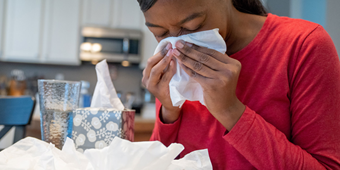How To Avoid the Risk Of Repeat Lung Infections

Answer a few questions and we'll provide you with a list of primary care providers that best fit your needs.
Breathe in. Breathe out. Repeat about 20,000 times a day.
Luckily, you don’t have to think about breathing. Your lungs do it for you. Still, a little thought can go a long way in keeping your lungs healthy and free from bronchiectasis.
Sometimes described as a chronic lung disease,
Bronchiectasis is a condition that occurs when the breathing tubes (airways) in your lungs become damaged and have difficulty getting rid of mucus.
Some mucus is normal and beneficial. But when too much mucus builds up, bacteria can grow and cause infection. Repeat infections cause even more damage to your airways, and over time, breathing becomes harder and harder.
Early diagnosis and treatment is critical. The sooner you begin treatment of bronchiectasis and any underlying conditions, the better your chances of preventing further infection and lung damage.
Currently, bronchiectasis has no cure. However, with treatment, it’s possible to achieve a good quality of life without major disability.
What Causes Bronchiectasis?
 Bronchiectasis can occur at any age. It can be congenital (present from birth) or acquired due to another condition, such as a lung infection.
Bronchiectasis can occur at any age. It can be congenital (present from birth) or acquired due to another condition, such as a lung infection.
Examples of lung infections that can lead to bronchiectasis include:
- Fungal infections
- Severe pneumonia
- Tuberculosis
- Whooping cough
- Measles
People who have these conditions are also at risk for bronchiectasis:
- Airway blockage (growth, non-cancerous tumor, inhaled object/hard food)
- Autoimmune disorders, such as rheumatoid arthritis, Sjögren's Syndrome, or Crohn’s disease
- Cystic fibrosis
- Chronic (ongoing) pulmonary aspiration (inhalation of food, liquids, saliva, or vomited stomach contents into your lungs)
- Cilia disorders (cilia are small, hair-like structures that line your airways)
- Immunodeficiency disorders such as HIV and AIDS
- Leukemia and related cancers
Cystic fibrosis leads to almost half the cases of bronchiectasis in the United States, according to the National Heart, Lung, and Blood Institute. Few cases are caused by whooping cough and measles due to availability and use of vaccines and antibiotics.
The most common signs and symptoms of bronchiectasis are:
- A daily cough that occurs over months or years and brings up mucus that’s often foul smelling
- Shortness of breath and wheezing (a whistling sound when you breathe)
- Chest pain that is sudden and stabbing and can spread to your shoulder or belly
- Clubbing (the flesh under your fingernails and toenails gets thicker)
Other symptoms may include fatigue, coughing up blood, paleness, and weight loss.
How To Lower Your Bronchiectasis Risk
You can reduce your bronchiectasis risk by preventing lung infections and through prompt treatment of lung infections, which is especially important for children. Here are ways to help reduce your risk:
- Avoid toxic fumes, gases, smoke, and other harmful substances
- Avoid close contact with people who have colds or flu
- Don’t smoke or be around others who smoke
- Ensure children get the whooping cough and measles vaccines
- Get your annual flu vaccine
- Talk to your doctor about getting the pneumonia vaccine
- Keep children (and adults) from inhaling small objects (toy pieces) or hard foods and seek immediate treatment when it happens
- Stay indoors when the pollution level is high
- Wash your hands often
Bronchiectasis Treatment
Early diagnosis and treatment is critical since bronchiectasis can lead to serious health problems, such as respiratory failure and heart failure.
Treatment goals are to treat infection, remove mucus from your lungs, and prevent complications through the following methods:
- Antibiotics to treat infection
- Bronchodilators to open up airways
- Chest physical therapy (Your doctor or a respiratory therapist may teach you airway clearance techniques that can help you cough up mucus.)
- Corticosteroids to treat airway inflammation
- Expectorants to help loosen mucus
- Hydration and mucus-thinning medicines
- Oxygen therapy, in some cases
- Treating an underlying disease or condition that causes bronchiectasis. In some cases, this can slow or prevent disease progression.
Your doctor may recommend surgery if your bronchiectasis is isolated to a section of lung, you experience a lot of bleeding, or no other treatments have helped.
In very rare instances of severe bronchiectasis, your doctor may recommend that you receive a lung transplant.
Answer a few questions and we'll provide you with a list of primary care providers that best fit your needs.
Source: National Heart, Lung and Blood Institute, U.S. Department of Health & Human Services; Medline Plus, U.S. National Library of Medicine; Bronchiectasis, Healthwise, 6/9/2019




